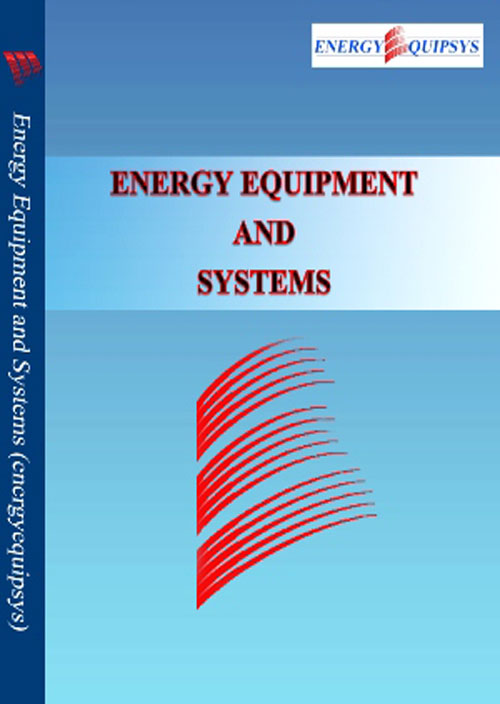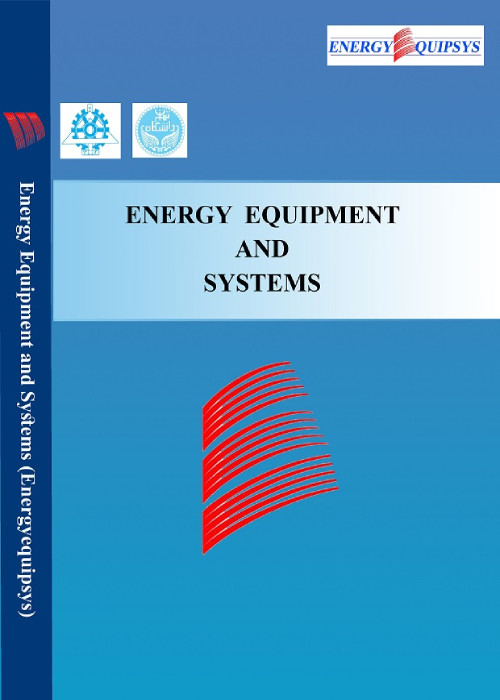فهرست مطالب

Energy Equipment and Systems
Volume:8 Issue: 4, Autumn 2020
- تاریخ انتشار: 1399/09/28
- تعداد عناوین: 7
-
-
Pages 307-322
In recent decades, the release of flare gases from different units of chemical industries into the atmosphere has become a substantial environmental problem all around the world. Therefore, recovery or use of flare gases has become much more critical. Combined heat and power generation from flare gases is one of the most economical methods for recovering flare gases. Two power generator gas cycle power plant or a combined cycle power plant can be used to generate heat and power. In this research, simulation and economic evaluation of heat and power generation from flare gases in a gas cycle power plant and combined cycle power plant using PRO/II v.10 software. Finally, by changing the effective operating parameters such as air to treated flare gas ratio, the outlet pressure of compressors, outlet pressure of steam and gas turbine, outlet pressure of pumps and adiabatic efficiency steam and gas turbine, heat and power generation and total capital and operating cost were investigated and analyzed. The results of simulation and sensitivity analysis showed that the use of flare gas with a mass flow rate of 9700 kg/h (mole fraction of CH4: 0. 84) could be used to construct a combined cycle power plant with a capacity of 115 MW with an investment cost of 100 M$. This value of energy surpasses the need for an average community with 85000 families, and the excess can be sold to the national grid.
Keywords: Flare Gases, Combined Cycle Power Plant, Simulation, Membrane Process, Assaloye -
Pages 323-338Concerning wind power penetration into power systems in recent years, the problems of incorrect operation of wind turbines include sub-synchronous resonance (S.S.R.) oscillations and fault ride through (F.R.T.) capabilities need to be fully considered and resolved. In this respect, the S.S.R. phenomenon can severely damage the rotor of an asynchronous generator in a compensated power system with capacitive reactance connected to a wind turbine. Therefore, active and reactive powers of the mentioned systems are controlled by static synchronous compensator (S.T.A.T.C.O.M.) and series dynamic braking resistor (S.D.B.R.); respe ctively. Moreover, power system designers combine them to improve system sta b i lity. In this study, an appropriate method was presented based on the genetic algorithm (G.A.) to provide coordinated and optimal control of STAT CO M and S.D.B.R. in order to mitigate S.S.R. and enhance F.R.T. capabilities in a wind far m connected a power system. Optimization variable of this pro blem included resistance value of S.D.B.R., S.T.A.T.C.O.M. capability, along with its control parameters optimized simul tane ou s ly via G.A. to store kinetic energy in the rotor, to control voltage dev ia tions of the wind farm bus, and to minimize speed deviations of the rotor. The prop osed method was implemented on the Institute of Electrical and Electronics Engineers (IEEE) first benchmark model to verify the performance of its control structure. The obtained results indicated that coordinated and optimal combin ati o n of S.T.A.T.C.O.M. and S.D.B.R. could damp S.S.R. oscillations and augment system stability.Keywords: Sub-Synchronous Resonance, Fault Ride Through, Optimization, S.D.B.R, S.T.A.T.C.O.M
-
Pages 339-348Solar adsorption refrigeration systems are used to extract heat using solar radiation based on the adsorption phenomena. In these systems, the temperature of the solar collector plays an important role in the efficiency of a system. In this study, two different models, including the lumped and the distributed ones, are investigated to predict the temperature distribution in a specific solar collector. The operating conditions are the same for both cases. Moreover, for the solar radiation as one of the boundary conditions, the data for Tehran solar irradiation is used. The results of the temperature analysis show that the distributed model predicts a less maximum collector temperature than the lumped model which clearly results in a lower system performance. In addition, it can be concluded that because of using steel as a main material for the collector and its high thermal capacitance, it takes almost 3 days for the system to reach the periodic operating conditions.Keywords: Solar Adsorption, Activated Carbon, Methanol, Distributed Model, Lumped Model
-
Pages 349-365This paper deals with thermodynamic modeling and proposal new configurations of an indirect water bath heater used in a city gate station (CGS) to preheat the natural gas (NG). In the transmission pipeline of natural gas before reducing NG pressure, it is necessary preheating to prevent hydrate formation. In the traditional systems, an indirect water bath heater is used for this purpose. Thermodynamic modeling of the proposed systems has been done in EES software, and an effective analysis based on proposed new configurations is conducted. The results indicate that using exhaust combustion products to preheat the combustion air can increase the thermal efficiency of the system from 46.36% (for base case) to 73.84%. In addition, with the use of an ORC to utilize the exhaust waste thermal energy, the system efficiency of 55.27% with an electrical output of 79 kW can be achieved. A comparison between configurations indicates that the second configuration (preheating combustion air) with 78.97 kg/h has the lowest emission rate.Keywords: Indirect Water Bath Heater, Energy Efficiency, Excess Air, combustion
-
Pages 367-388Film cooling is an effective method to keep the gas turbine blades from high temperature gases and thermal stresses. Square pulsating film cooling on different sections of a modified NASA C3X blade is numerically investigated. Temperature distribution and film cooling performance are investigated for various blowing ratios of 0.5, 0.75, 1.0, 1.5, 2 and 2.5 in pulse frequency of 50Hz. Reynolds-Averaged Navier-Stokes equations for steady and pulsating injection considered. The shear stress transport ( ) model applied for turbulence effects. Simulations are performed using finite volume method. Obtained results show different findings of pulsating film cooling on the various blade surfaces. For large blowing ratios, averaged pulsed film covering effectiveness at leading edge and pressure side of blade is reduced compared to small and middle values of blowing ratios. This trend is reversed in the suction side. Reynolds number of mainstream has the maximum effect on film effectiveness distribution on pressure section. The averaged centerline pulsed film coolant performance on the pressure surface and leading edge at blowing ratio of 0.5 and for suction side at blowing ratio 2.5 was maximum.Keywords: numerical simulation, blade, Film cooling, Square Pulsation, Effectiveness
-
Pages 389-399
Today, utilizing renewable and clean sources of solar energy by solar systems is continuously increasing. Given that the output power of solar cells is dependent on radiation intensity, temperature, and voltage of the terminal, controlling their performance in order to maximum absorbed power has high importance. The high photovoltaic temperature in hot seasons leads to reduce panel power. Therefore, the water spraying on the photovoltaic panel was implemented on the photovoltaic panel. The effect of spraying water on the photovoltaic panel showed that spraying water on the panel during a warm day can significantly improve the panel's power. In this work, non-potable water (green space irrigation) has been used to cool and clean the photovoltaic panel. Reducing the price of photovoltaic systems by using fewer panels due to achieved of the panels to the more power is another significant advantage of spraying water on the photovoltaic panel. Results show that the efficiency of the experimented system increased by 20%.
Keywords: Renewable Energy, Photovoltaics System, Solar Energy -
Pages 401-425The major problem regarding conventional rice mills is the use of fixed-bed drying systems, which is accompanied by high energy consumption. In this study, a novel solar-assisted fluidized-bed system for drying paddy grains was used. The system included a solar water heater, an infrared lamp powered by photovoltaic panels, along with a gas water heater, which were used together to provide the required thermal energy. The working factors were drying air temperature (35, 45, and 55 °C), drying air velocity (7, 8, and 9 m/s), and the angle of the desiccant wheel regeneration gate (0, 45, and 90 degrees). The performance characteristics of the drying system were measured in terms of drying rate, total energy consumption, solar fraction and energy efficiency. Several mathematical models were also applied to fit the moisture ratio curves. In order to analyze the results and obtain the optimized working conditions of the drying system, Response Surface Methodology (RSM) based on the Box–Behnken technique was used. In all of the evaluated conditions, the model entitled “Approximation of diffusion” had the best results for fitting the moisture ratio curves with a correlation coefficient value of at least 0.9729. The selected optimum point included drying air velocity of 7 m/s, drying air temperature of 52.77 ºC and regeneration gate angle of 0. Under the mentioned working conditions, the drying time of 75.99 min, the total energy consumption of 0.297 kWh, solar energy fraction of 0.540 and energy efficiency of 47.67% could be obtained with a desirability value of 0.970.


